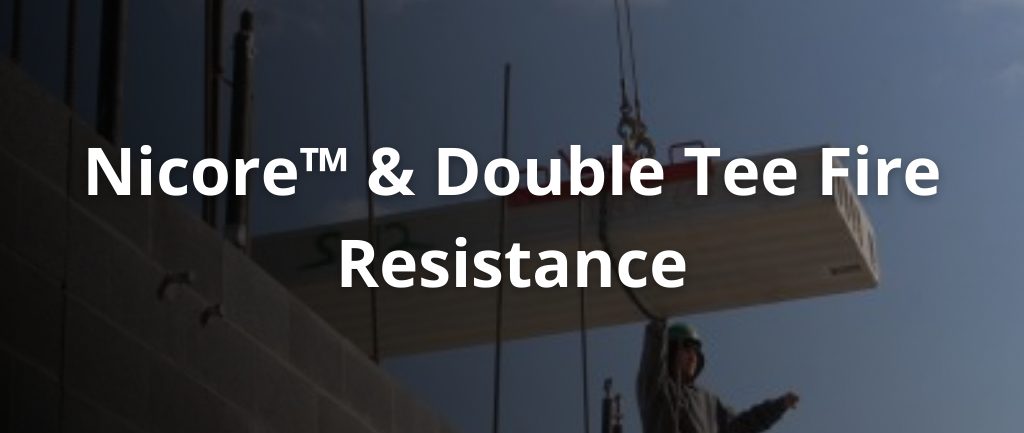DOUBLE TEE FLANGE – FIRE RESISTANCE
This is an update to a blog we previously posted in 2016 that captures what has transpired since then. As such, it provides a historical perspective along with information on contemporary practice to help explain why we are, where we are, today.
High-performance, precast, prestressed double tees have been the go-to structural floor framing in parking structures for many decades, and there is no reason to think they will not continue to do so into the future. They are easily capable of supporting vehicular automotive live loads while free-spanning common 60’-0” parking modules, thus improving the Level of Service (LOS) and providing a user-friendly parking experience.
Parking structures are assigned Occupancy Group S-2 (Low-Hazard Storage) by the International Building Code (IBC). IBC has numerous parameters to direct the designer in establishing the Construction Type, but the lion’s share of open parking garages comply with Construction Type 2A. For tier areas ≤ 50,000 s.f. and building heights ≤ 10 tiers this results in a 1-hour fire resistance rating for floor construction in Construction Type 2A. Occasionally, however, limited openness, larger tier areas, or a greater number of tiers requires a more restrictive classification such as Construction Type 1A or 1B. These result in a 2- hour fire resistance rating for the floor construction.
The following historic discussion focuses on IBC 2012, though the concepts and provisions stated are also applicable to prior IBC versions. Furthermore, the topic is limited to thickness requirements for the double tee flanges, whereby 4” flanges for pre-topped double tees are nearly universal throughout the precast, prestressed industry, and easily support the IBC requirements for 3,000# concentrated loads from automobile jacks. However, prior to IBC 2015 only prescriptive-based criteria were recognized by IBC whereby 45⁄8” thick flanges were required to achieve a 2-hour fire resistance rating instead of permitting a performance-based analysis using 4” thick flanges. This section summarizes what transpired prior to adoption of IBC 2015.
- There are two primary and separate criteria of achieving a specified level of fire resistance, the structural endpoint and heat transmission endpoint fire endurance criteria as outlined in the Design for Fire Resistance of Precast/Prestressed Concrete (MNL-124-11) published by the Prestressed Concrete Institute (PCI), which has been evaluated by the ICC Evaluation Service in ESR-1997 as being in compliance with the Building Code.
- IBC 2012, Table 601 listed a 2-hour fire-resistance rating for Construction Types 1A and 1B, with no additional specificity as to structural vs. heat transmission endpoint fire endurance criteria.
- IBC 2012, Table 722.2.2.1 prescribed a minimum concrete slab thickness of 4.6” when using carbonate aggregate to achieve a 2-hour fire resistance rating. Again, there was no additional specificity as to structural vs. heat transmission end-point fire endurance criteria, though it strongly implied conformance with heat transmission endpoint since no reference was made to its reinforcement.
- IBC 2012, Table 508.4 obviously did not require a separation when the entire structure occupancy was S-2.
- IBC 2012, Section 510.3.4 did not even require protected openings through floor assemblies between Group S-2 (enclosed parking garages) and Group S-2 (open parking garages).
- IBC 2012, Section 714.1.5 did not require fire resistant joint systems through floors within open parking structures.
Since openings through parking levels (including ramps) do not require protection, and since the joints between the double tee joints do not require protection, one can reasonably infer that allowance of flame passage is permitted. Since passage of flame is permitted and could ignite combustibles on the opposing surface it stands to reason the heat transmission endpoint fire endurance rating, which is a function of elevated flange temperatures, is neither a design consideration nor a limiting criterion. The structural endpoint fire endurance rating still assures, however, that a more localized event like a car fire will not collapse the structure. This design methodology permits the flanges of the double tees to remain at the standard 4” thickness since the heat transmission endpoint fire endurance is not applicable, while the reinforcing in the double tees flanges and stems is proportioned to achieve the 2- hour structural end-point fire endurance rating.
This topic was discussed extensively Chapter 10.8 in the PCI Design Handbook (MNL-120-10, 7th Edition). The following text is an excerpt taken directly from this section to substantiate waiving the heat transmission end-point criterion…
“In general building construction, other considerations for fire resistance are heat transmission and flame passage through the horizontal floor system. Both end point criteria are defined in ASTM E119. Due to the physical characteristics of a parking structure, however, these criteria are generally deemed not applicable to this type of construction. The vast open space on and between floor levels makes compartmentalization of a fire virtually a non-issue, since heat and smoke transmission throughout the building is uninhibited. Further, in the interior of many parking decks, ramp or litewalls provide support for the floor system. These are wall components with large openings to allow for greatly enhanced lighting and, therefore, security for the user. In effect, between the ends of adjoining bays, vertical air shafts are created in the gap between the ends of the double-tees, roughly equal to the thickness of the supporting wall times the distance between stems, less the width of the supporting wall column section. If floor openings such as these are not required to be enclosed it is illogical to require either of the end point criteria discussed previously in the determination of fire resistance; that is generally the basis of their being waived. The code specifically recognizes this in allowing an exception for fire-resistant joint systems in open parking structures (Section 713.1 of IBC 2006).”
“Research was performed to evaluate realistic vehicle fire loads (time-temperature or time-heat flux relationships) for precast concrete parking structures, and to investigate the influence of structure geometry and fire characteristics on the resulting fire loading. A typical precast concrete parking structure was analyzed for a series of vehicle fires, and the resulting fire loads at various points in the structure were determined. Fire analyses were run on nine simplified parking garage models. Seven analyses were single-vehicle fires, and two analyses were sequential, multiple-vehicle fires. Analyses were performed using the Fire Dynamics Simulator (FDS), a computational fluid dynamics computer program. Heat flux time-histories from the FDS analyses were used as input to subsequent heat-transfer finite element analyses to determine the temperature rise in the prestressing strand of the double-tee floor components. Results show
that the highest steel temperature reached in any of the analyses occurred in analysis 9, which involved a multiple-vehicle fire confined to one floor of the parking structure. In this analysis, the peak gas temperature and peak heat flux at a given double-tee location were similar to a single- vehicle fire, but because more than one vehicle was burned, the duration of the thermal input to any location was longer than for a single vehicle fire. Using the equations for reduction in strength in prestressing steel as a function of temperature, the impact of the fire loading was evaluated. The maximum temperature reached in the concrete at the level of the prestressing steel corresponded to a strength reduction in the prestressing steel of about 20%. For all of the single-vehicle fire analyses, the concrete temperature at the level of the strand is much lower, with a maximum temperature corresponding to about an 8% reduction in prestressing steel strength.”
Since introduction of IBC 2015, and continuing with IBC 2018 and IBC 2021, Table 722.2.2.1 prescribes a minimum concrete slab thickness of 4.6” when using carbonate aggregate to achieve a 2-hour fire resistance rating. However, in all three (3) of these codes there is a clear exception in Section 722.2.2.1 stating the “minimum thickness shall not be required for floors and ramps within parking garages construction in accordance with Sections 406.5 and 406.6”. This provision precludes the historic arguments described earlier, and the need to defend the use of performance-based design to justify acceptance by the code official to permit designers to detail standard 4” flange thicknesses. Not only does this take advantage of modular precast construction without the need for expensive form modification, but it reduces the weight of the structure by nearly eight (8) psf and saves nearly three (3) tons per truckload of freight cost.
Choose with confidence and make NCP your single source for precast – what you need when you need it.
Nitterhouse Concrete Products, Inc. in Chambersburg, PA, is a family-owned company serving the construction industry since 1923. Give us a call at 717-267-4505 or contact us online for information on more quality precast, prestressed products to meet your design and construction needs.
Contact Nitterhouse Concrete Today




